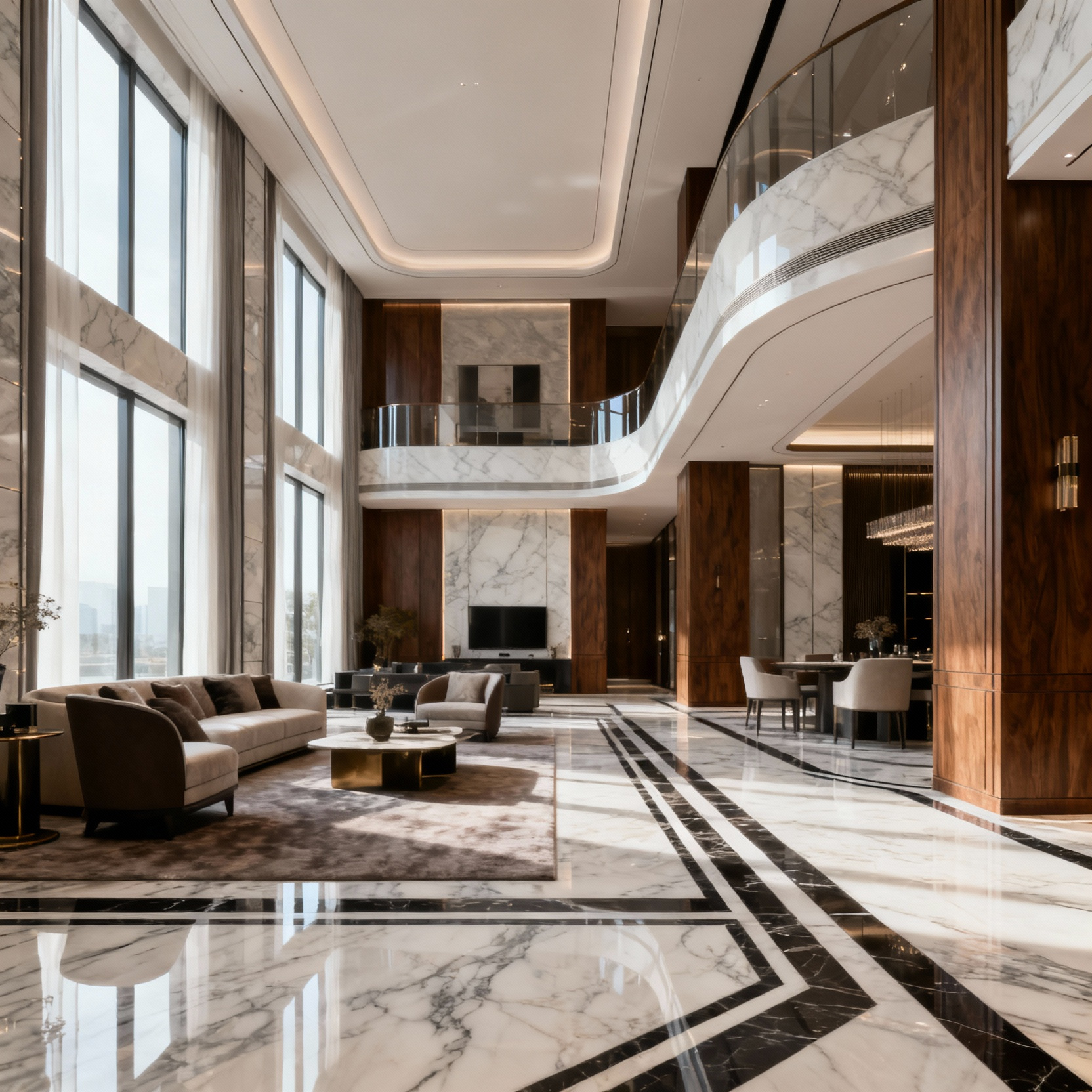Designing a space is, fundamentally, an act of revealing oneself—every choice reflects not just an aesthetic preference, but deeper convictions about how life should be lived. The most compelling interiors aren’t decorated; they’re authored. They tell coherent stories about their inhabitants’ journeys and aspirations, and their understanding of beauty’s role in the everyday. These twenty paradigms separate spaces that feel genuinely resonant from those that simply look expensive.
Indeed, the soul of an exceptional dining room is found in an intricate balance of architectural harmony, a carefully orchestrated sensory experience, and thoughtful personal expression. It’s within these four walls that memories are forged, conversations flourish, and the subtle art of hospitality unfolds. Discerning homeowners and designers understand that superlative dining room designs are not about opulent fixtures alone. They are about crafting an immersive experience—a space that enchants the eye and invites genuine connection.
In this exploration, we will move through twenty distinguished principles that define the pinnacle of luxury dining room designs. Our journey is structured into three pivotal parts: first, understanding the Architectonics of Ephemeral Grandeur, which examines the Foundational Principles shaping a refined space. Second, we uncover the Lexicon of Luxury, revealing how bespoke details and integrated artistry elevate the ambiance. And finally, we contemplate The Convivial Nexus, exploring the philosophical heart of truly elevated dining. Prepare to discover the art of convivial splendor.
Architectonics of Ephemeral Grandeur: Foundational Principles for a Refined Dining Salon (Part 1)
In the world of high-end interior design, the dining room is far more than a functional area. It is a canvas for intention and an incubator for memorable experiences. This first section explores the foundational principles that underpin truly sophisticated dining room designs, laying the groundwork for spaces that possess an ephemeral grandeur through a meticulous consideration of space, light, materials, and proportion.
1. Mastering the Interstitial Volume: Strategic Spatial Delineation and Flow Dynamics
The most elegant dining rooms aren’t born from a decorative impulse. They begin with a rigorous understanding of space itself—of volume, and the subtle dance of movement within it. Mastering this interstitial volume, the often-overlooked space between objects, is essential for achieving a sense of ease and unconstrained elegance. It’s about orchestrating flow before you ever choose a finish.
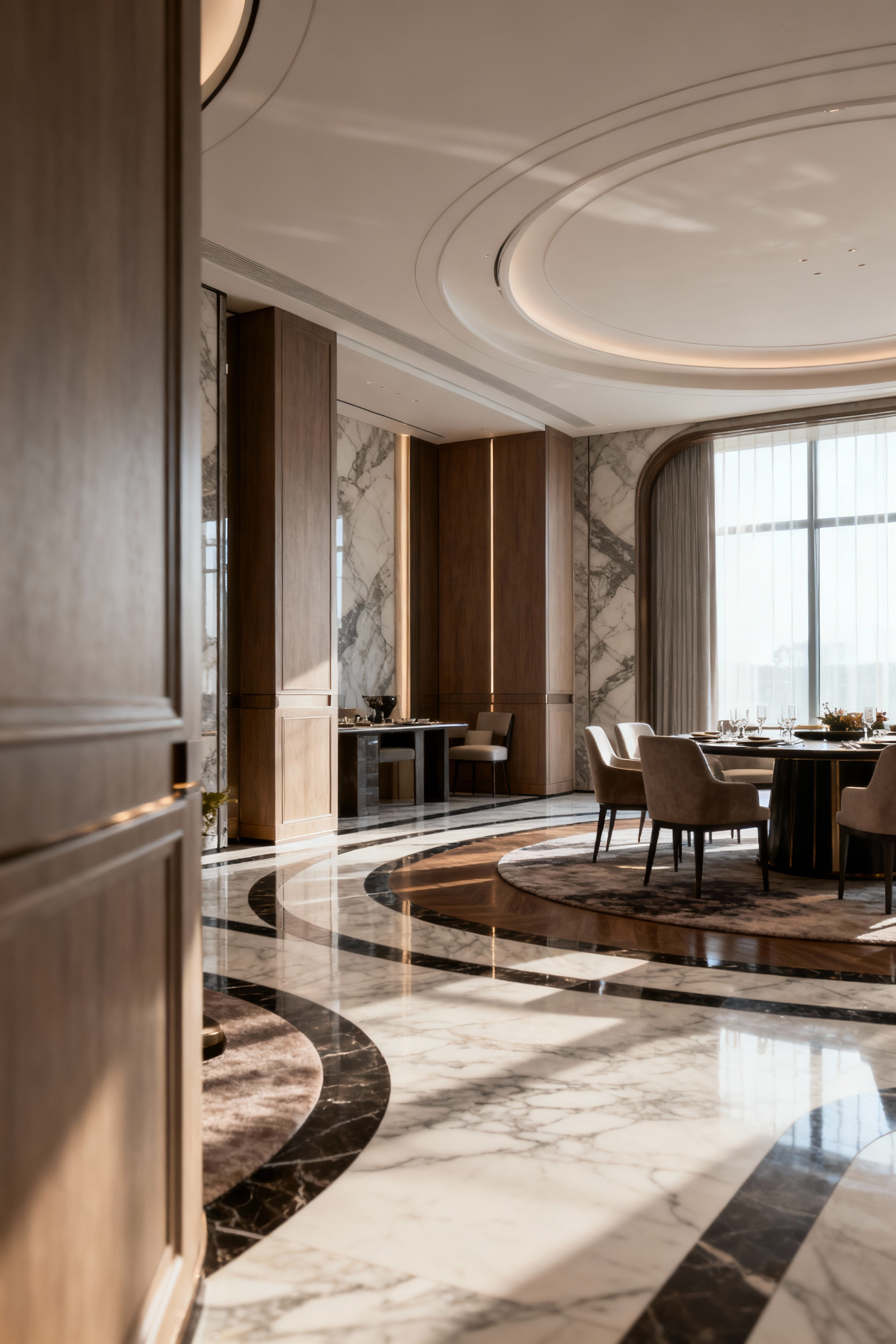
This goes beyond simple clearances. A space must intuitively guide guests, allowing for seamless entry and effortless interaction, even when the room is full. Think about the stark difference between an open-concept layout and a formal, enclosed dining room. While the former offers a modern, communal feel, the latter provides an unparalleled intimacy, turning the meal into a dedicated event. The goal is to imbue the space with a logic that feels both expansive and exquisitely contained.
2. Harmonizing the Luminous Tableau: Orchestrating Layered Illumination for Mood and Function
Light, more than any other element, transforms a room into a sanctuary. Harmonizing the luminous tableau is a sophisticated art form, demanding a meticulous orchestration of layered light for both function and mood. Elite dining room designs move beyond a single overhead fixture, embracing a multifaceted approach that sculpts space and fosters emotion. In my luxury design practice, I’ve found that getting the lighting right is ninety percent of the battle; a well-lit room with simple furnishings will always feel more luxurious than a poorly-lit room filled with expensive pieces.
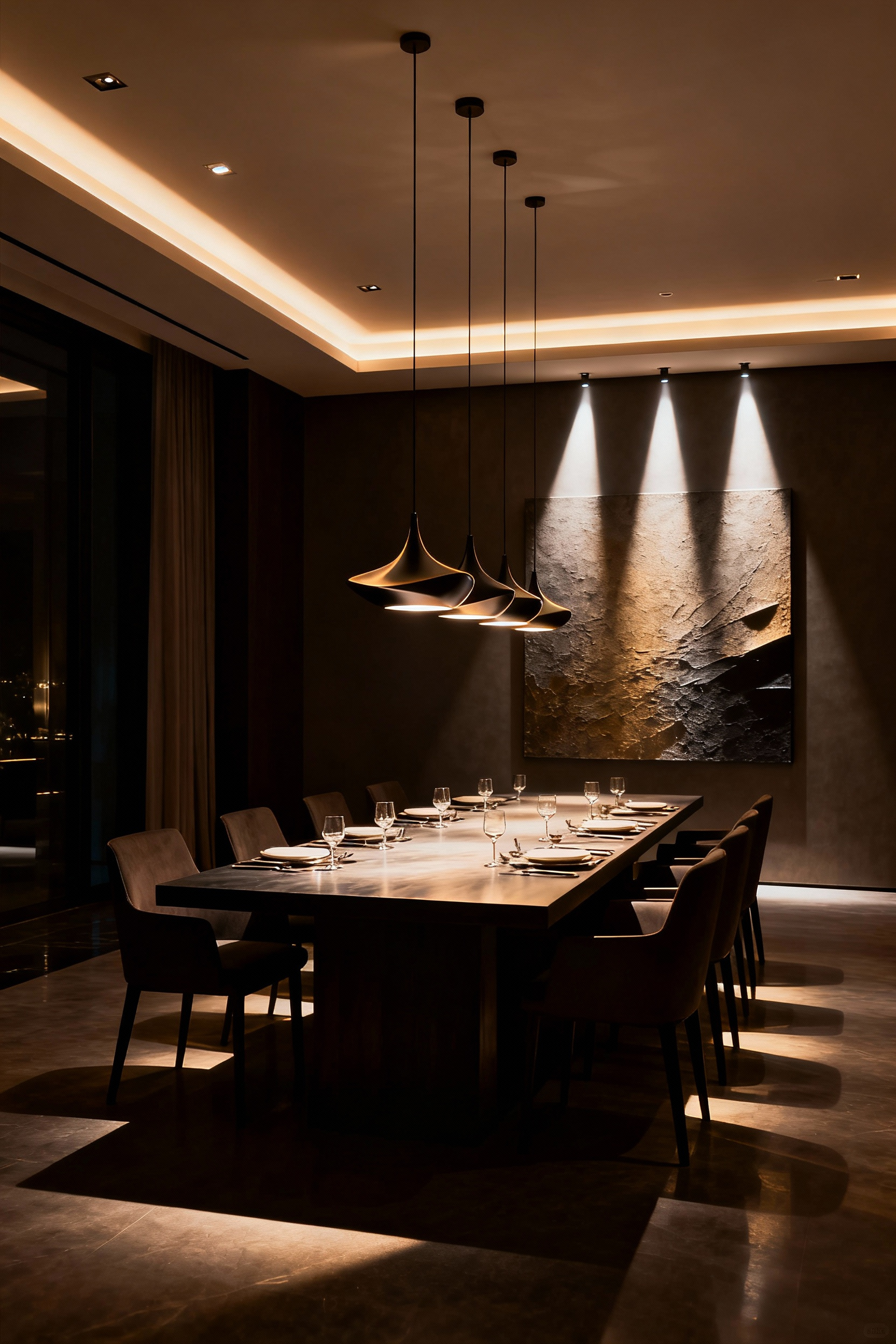
A truly refined scheme needs ambient, task, and Accent Lighting. The chandelier, a timeless icon, should be scaled to the room and hung so it radiates a welcoming glow without impeding sightlines. Crucially, all ambient light must be on a dimmer. It’s non-negotiable. Accent lighting, however, is where the real magic happens—highlighting art, architectural features, or a floral arrangement. The ultimate goal is to create a luminous landscape that feels intuitive and responsive, calibrated precisely to the moment.
3. Discerning the Tactile Narrative: The Prerogative of Material Palettes and Surface Integrity
The materials in a dining room whisper tales of craftsmanship and permanence. Beyond just visual appeal, the tactile quality of a space profoundly influences its perceived value. Every material—a slab of Italian marble, a warm plank of oak, a rich expanse of silk velvet—contributes a unique voice to the room’s story. This narrative is not accidental; it’s a meticulously woven tapestry of textures.
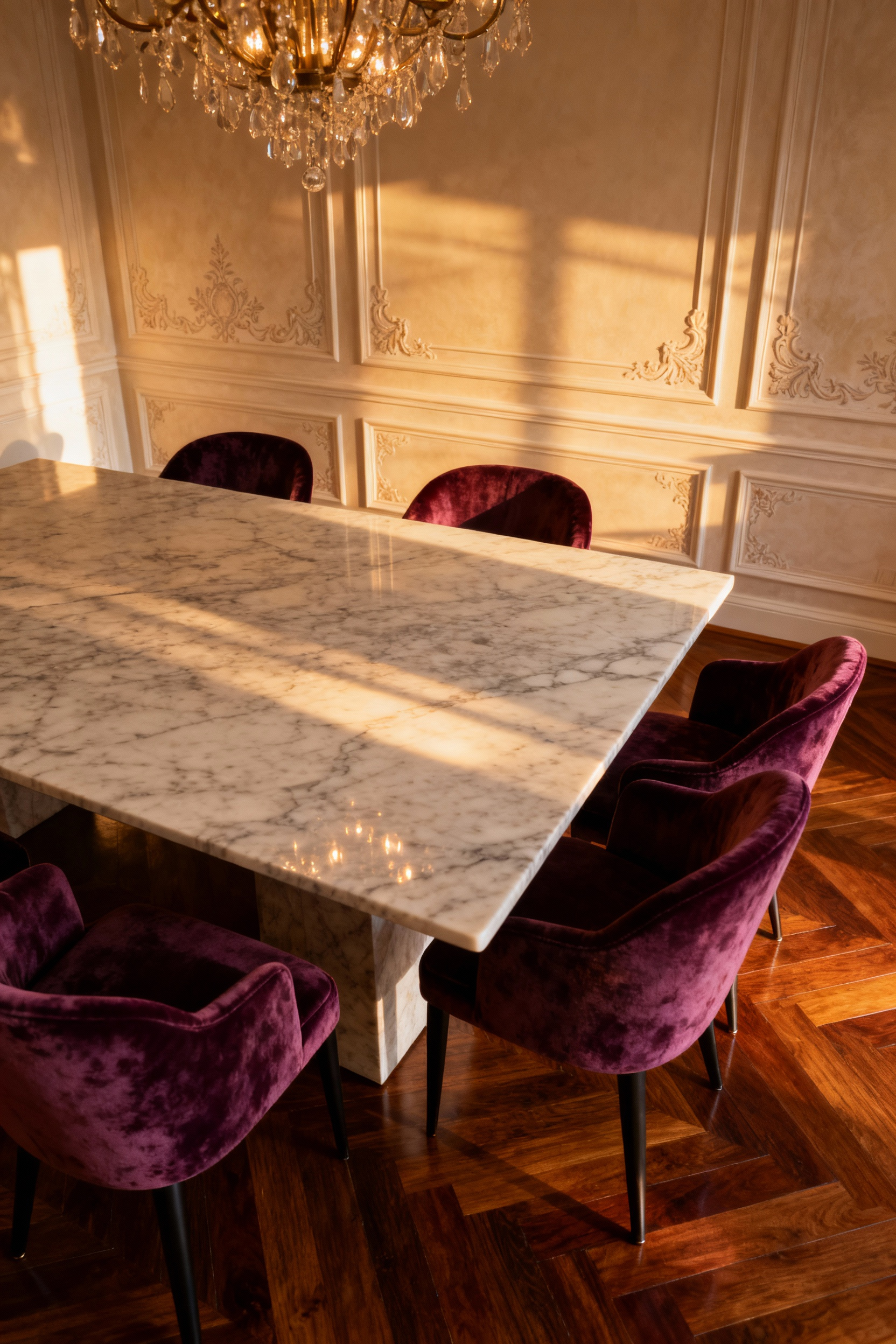
The dining table’s surface is the very heart of the experience. Will it be a honed stone top, with a sense of ancient gravitas, or a high-gloss lacquer reflecting modern brilliance? Contrast is key here; a rough-hewn console against a smooth wall, or silk curtains framing metal windows, creates a dynamic tension that delights the senses. Authentic materials like real timber, natural fibers, and handcrafted metals speak to an investment in quality that mass-produced substitutes simply cannot replicate, developing a rich patina over time that deepens the room’s character.
4. Cultivating Proportionate Symmetry: The Imperative of Scale and Balance in Furnishing Selection
The success of even the most beautiful dining room designs hinges on a deep understanding of scale and balance. This isn’t about rigid, mirrored symmetry, but an artful equilibrium that ensures every piece exists in harmony. A room feels intuitively right when its proportions are masterfully calibrated. It’s an invisible architecture of elegance.
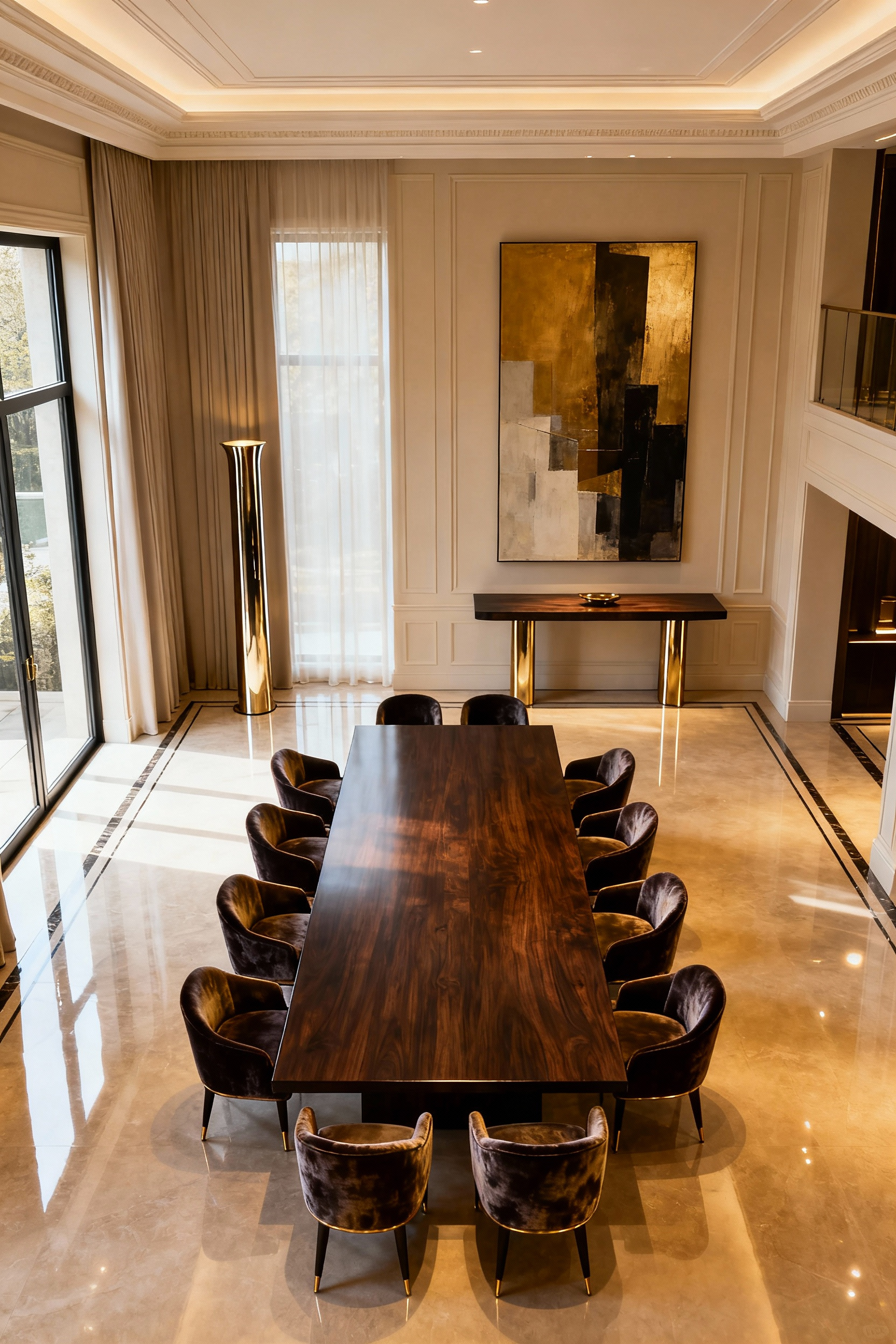
The dining table’s size must be commensurate with the room’s dimensions. Chairs, in turn, must be scaled not only to the table but to the human form, offering comfort without appearing cumbersome. But balance can also be asymmetrical. A tall, slender vase on one side of a console can be balanced by a low, heavy object on the other, creating a dynamic and contemporary appeal. Deliberately leaving areas unfilled—negative space—prevents visual claustrophobia and allows individual pieces to breathe, enhancing their impact.
Architectonics of Ephemeral Grandeur: Foundational Principles for a Refined Dining Salon (Part 2)
Continuing our look at foundational principles, we now focus on the elements that anchor the dining experience: the table and chairs. These are not merely utilitarian objects but critical expressions of aesthetic philosophy that shape the very essence of conviviality within any discerning dining room.
5. Anchoring the Gastronomic Hub: Selecting the Definitive Dining Table Form and its Corollaries
The dining table is the undisputed center of this gastronomic world. Its shape does far more than just fill a space; it determines social interaction and sets the aesthetic tone. A grand rectangular table, for example, evokes traditional formality and is perfectly suited to linear arrangements and stately affairs. An oval or round table, on the other hand, champions a more intimate, egalitarian exchange by eliminating hierarchical seating and promoting easy conversation.
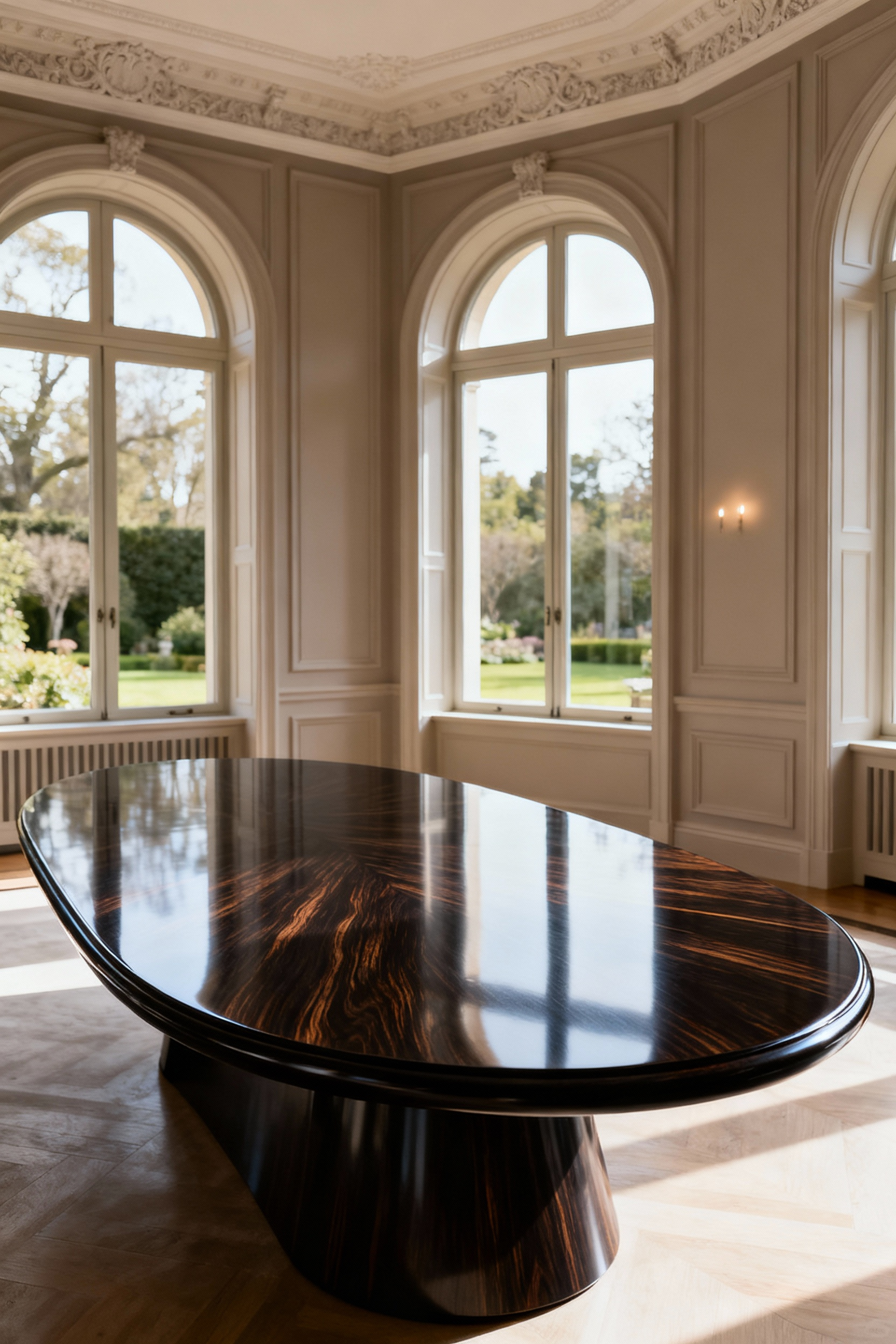
Materiality refines these forms. A weighty slab of mahogany speaks to legacy and gravity, while a glass top can introduce an ethereal lightness. The definitive selection becomes a meditative process, balancing form, material, and the desired narrative for the epicurean theater it’s designed to host. I learned this when a client chose a magnificent, dark wood table that was technically perfect for the room’s size, but its visual weight completely suffocated the light, airy feeling they wanted. We switched to a table with a similar footprint but a lighter stone top and slender legs, and the entire room came alive.
6. Enriching the Ergonomic Sanctuary: Curating the Seating Typology for Enduring Comfort and Visual Cohesion
Beyond the table, the dining chairs enrich the room’s ergonomic sanctuary, providing essential comfort and a stylistic counterpoint. This is a nuanced art, balancing the body’s needs with aesthetic imperatives. Armchairs, particularly at the heads of the table, impart a sense of permanence and sophisticated ease, ideal for leisurely meals. Slender side chairs, meanwhile, allow for greater capacity without overwhelming the room.
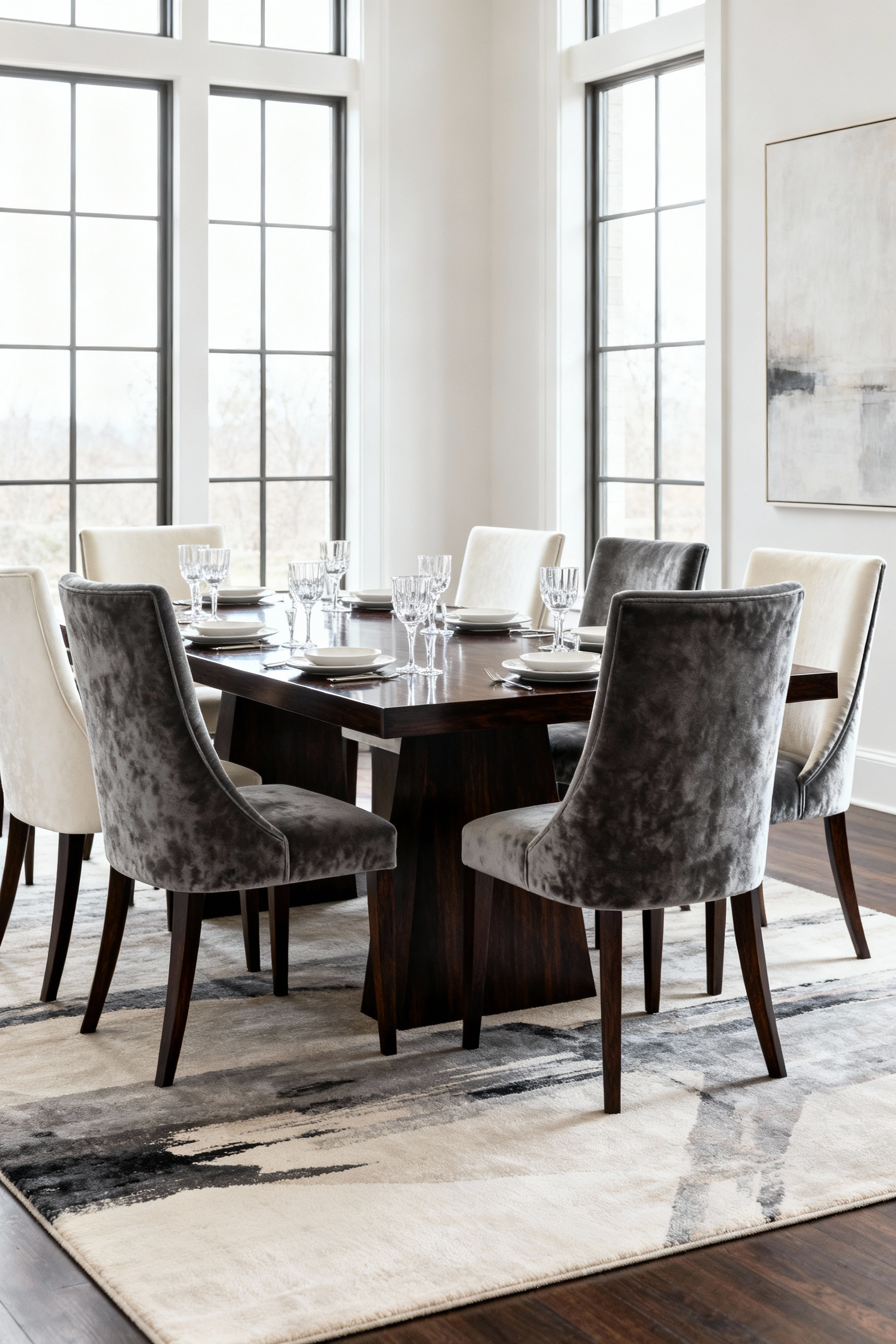
Ergonomics are simply non-negotiable in luxury dining room designs. A beautiful chair that isn’t comfortable is a failed design. Stylistically, chairs don’t need to match the table. In fact, a thoughtful divergence often introduces depth—elegantly sculpted mid-century chairs paired with a rustic plank table, for instance, can create a thrilling dynamic tension. The objective is visual cohesion, a dialogue between forms that transforms mere seating into an integral part of the salon’s architectural poetry.
Lexicon of Luxury: Elevating the Gastronomic Ambiance with Bespoke Details and Integrated Artistry (Part 1)
True distinction in luxury dining room designs comes from a masterful orchestration of bespoke elements. This section explores how commissioned art, thoughtful acoustics, and botanical integrations can transform a space into a masterpiece of convivial splendor, infusing it with elegance and profound personal expression.
7. Infusing Bespoke Artistry: Commissioning Site-Specific Adornments and Sculptural Declarations
The pinnacle of luxury is often found not in off-the-shelf grandeur, but in the embrace of bespoke artistry. To commission a site-specific adornment is to infuse a space with an unparalleled narrative, creating a focal point that resonates deeply with the homeowner’s personal legacy. Art here is not an afterthought but an integral architectural component.
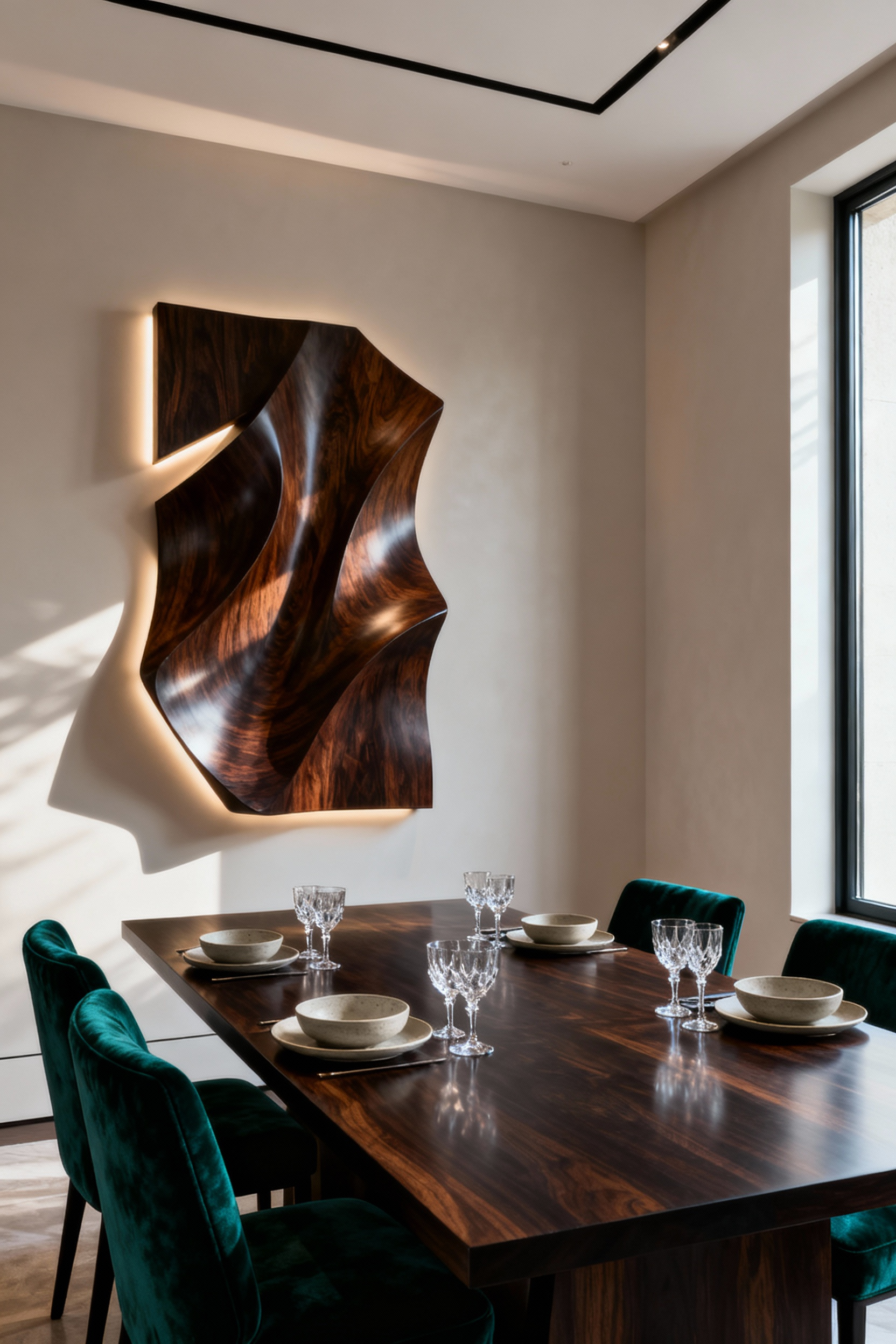
Imagine a grand dining table with a bespoke parquetry pattern designed by a master artist, echoing the ceiling’s geometry. Or a series of hand-blown glass sconces fabricated to cast a particular hue that enhances both the food and the complexions of guests. In my professional experience with Classical Design Elements, a space truly sings when a single, powerful artistic statement is allowed to command the room. A recent project featured a custom de Gournay wallpaper, and we designed the entire room around its colors and narrative. It became more than a dining room; it was an immersive world.
8. Curating the Acoustic Envelope: Mitigating Sonic Intrusions for Intimate and Refined Discourse
Beyond visual splendor, a truly luxurious dining environment is defined by its acoustic envelope. The goal isn’t silence but the subtle mitigation of sonic intrusions to foster refined conversation. Hard surfaces, while beautiful, often turn vibrant conversation into an unintelligible clamor. A room where every whisper is heard, where laughter resonates warmly without echoing, offers an unparalleled sense of calm and discernment.
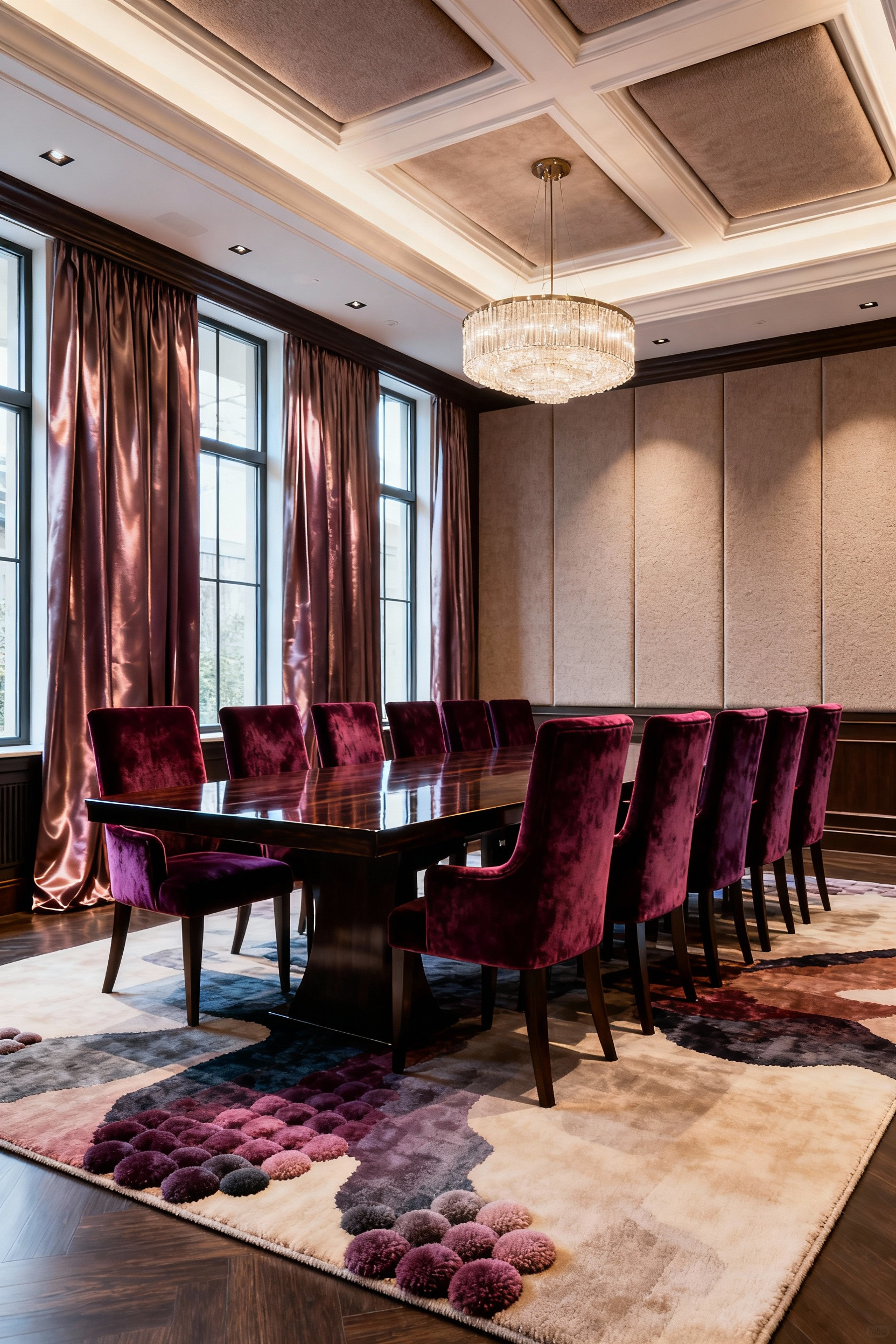
This moves beyond heavy draperies to integrating bespoke acoustic panels that look like fine art—a wall upholstered in rich silk jacquard, beneath which lies high-performance sound-absorbing material. Plush carpets dramatically reduce floor-level reflections, while upholstered seating absorbs the mid-range frequencies critical for speech clarity. This meticulous attention to the acoustic environment is an offering of true luxury—the luxury of undistracted presence.
9. Harmonizing Flora and Form: Integrating Botanical Grandeur with Strategic Horticultural Articulation
Integrating botanical grandeur is a sophisticated evolution in design, an exercise in bringing nature indoors with strategic articulation. Living elements transform a dining space into a vibrant, breathable sanctuary, offering an organic counterpoint to structured design components. Here, plants are not simply placed; they are curated for their sculptural qualities and their contribution to the room’s narrative.
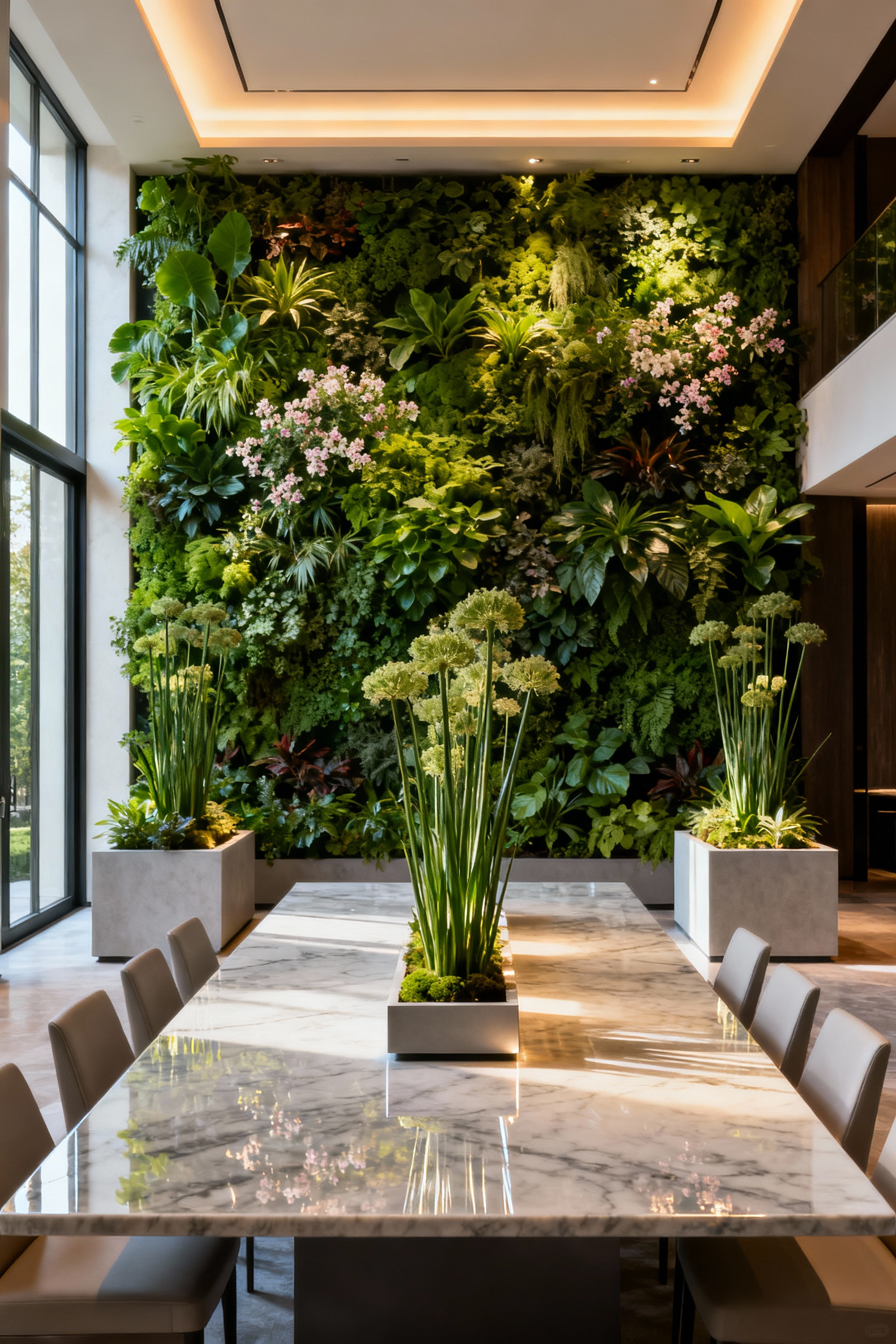
Advanced applications see botanical elements integrated with architectural precision. Imagine a custom planter recessed into a wall niche presenting a cascading veil of rare plants, or a magnificent Ficus Lyrata positioned to draw the eye upwards. For smaller statements, a perfectly sculpted Bonsai on a bespoke plinth commands quiet reverence. What I tell my clients and readers is to think of plants as living sculpture. One perfectly chosen tree in a beautiful vessel has more impact than a dozen small, scattered pots. It’s about intention.
10. Mastering the Art of the Pedestal: Displaying Objet d’art with Deliberation and Illumination
The distinction between possessing exquisite objects and truly celebrating them lies in mastering the art of the pedestal. This is about presenting objet d’art with such deliberate intention and artful illumination that each piece becomes a compelling focal point. The pedestal elevates an object not just physically but in perceived significance, allowing it to stand in proud isolation.
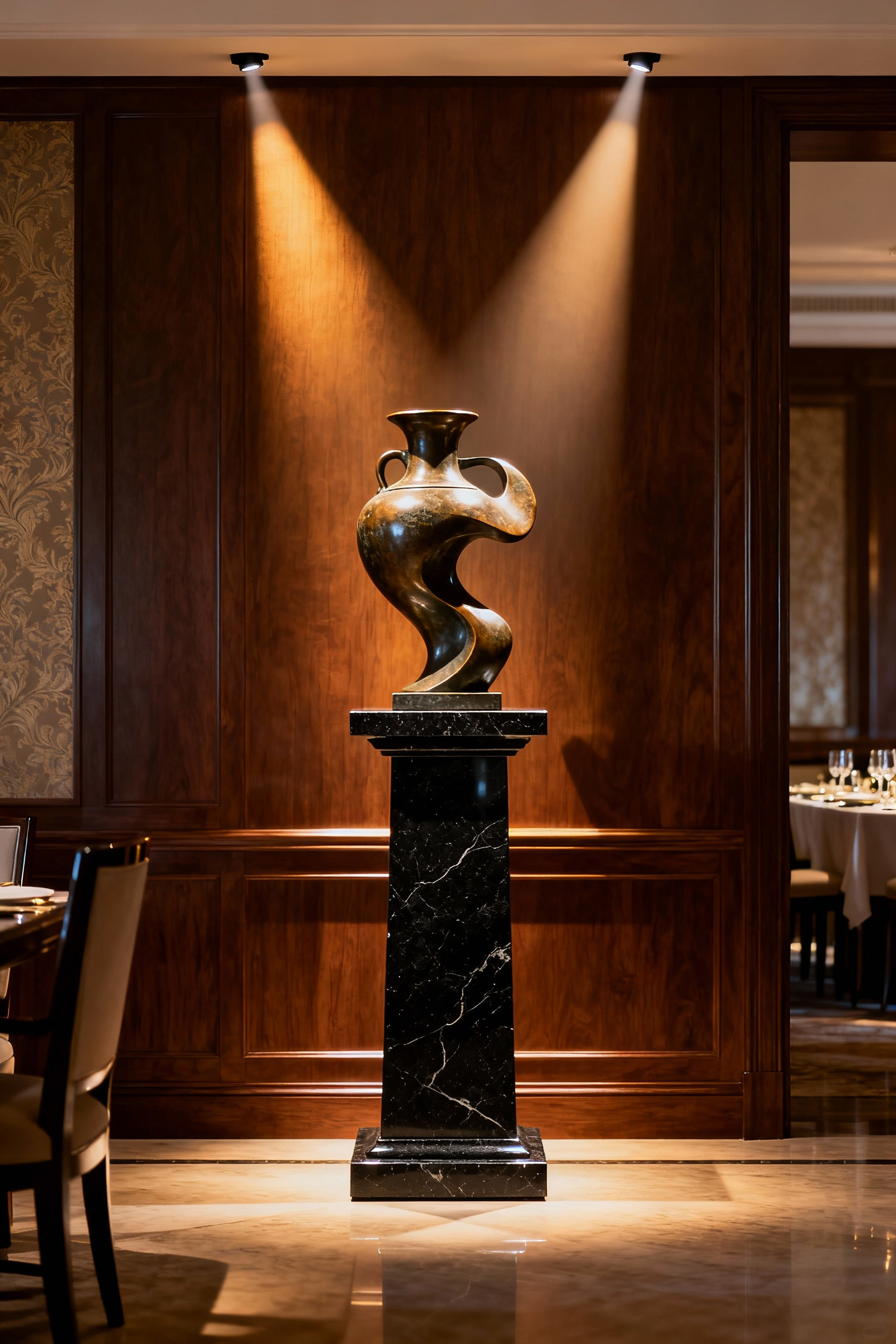
This goes beyond the utilitarian block to bespoke designs crafted from materials that complement the showcased piece—a marble column whose veining echoes the room’s stonework, for example. Integrated lighting is crucial, with concealed LEDs creating a dramatic glow or spotlights accentuating textures. This deliberate display transforms the act of viewing into a curated experience, inviting guests into a deeper appreciation of beauty and turning the dining room into a private gallery where every meal is accompanied by a silent dialogue between art and admirer.
Lexicon of Luxury: Elevating the Gastronomic Ambiance with Bespoke Details and Integrated Artistry (Part 2)
As we continue our exploration into the lexicon of luxury, we now turn to the nuanced orchestrations that define bespoke excellence. This segment delves into the judicious integration of technology, the artful application of architectural elements, and the curation of ancillary furnishings that sculpt an environment of unparalleled sophistication.
11. Synthesizing Digital Discretion: Integrating Smart Home Capabilities with Unobtrusive Elegance
Contemporary luxury includes the seamless integration of technology, executed with almost invisible discretion. The hallmark of a sophisticated smart system in a dining room is its ability to enhance comfort without ever disrupting the aesthetic integrity. The goal is an effortless command over the room’s environment—illumination, temperature, sound—that preserves the focus on human connection.
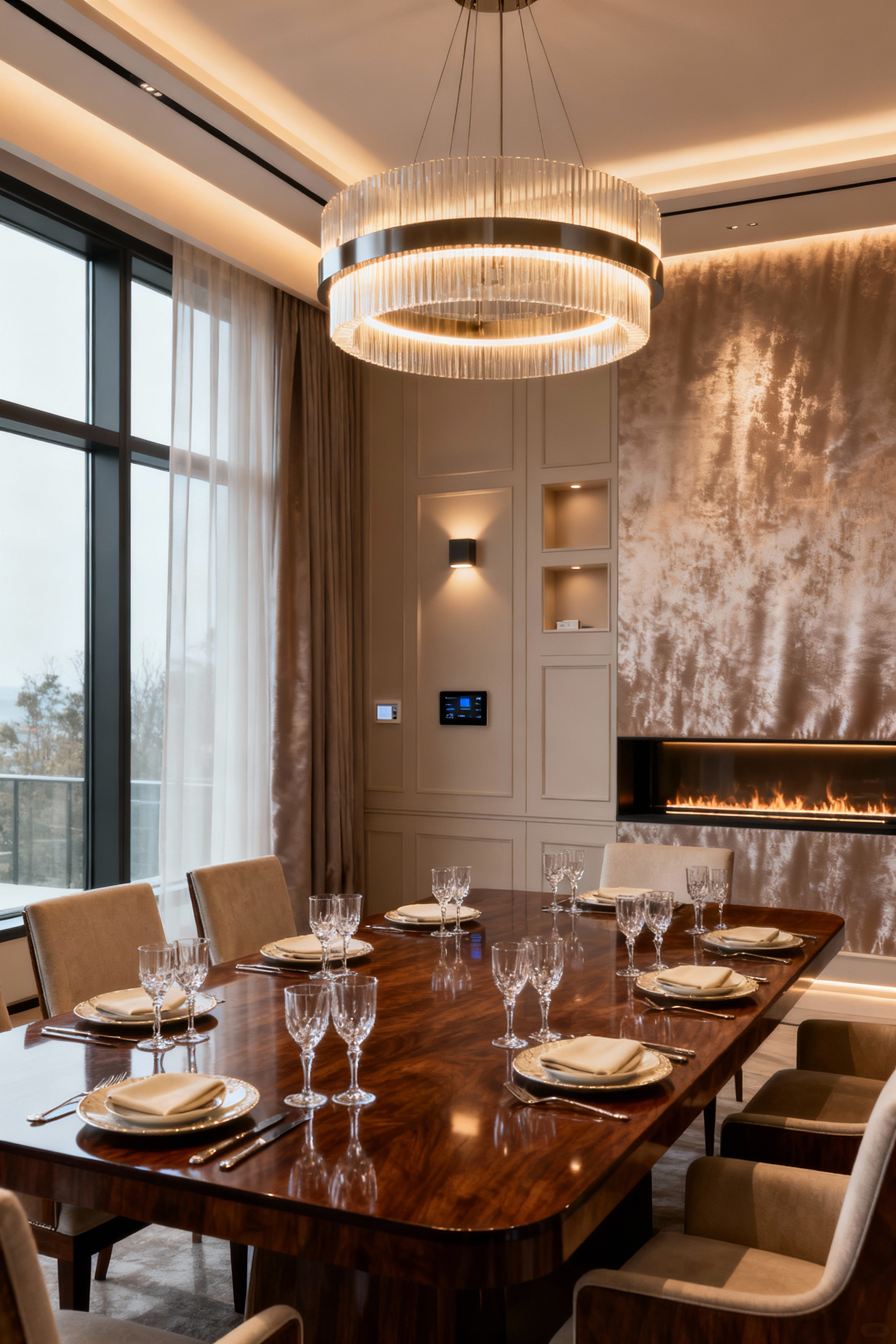
This means considering technology from the very first sketch. Lighting should be controlled via intuitive interfaces crafted from bronze or leather, not plastic panels. Climate control vents can be linear diffusers integrated flush into ceiling details. Automated window treatments must operate silently, their mechanisms hidden. This foresight prevents the jarring intrusion of electronics, allowing the aesthetic purity of the space to reign supreme. Years of high-end interior design taught me that the best technology is the technology you never see. It should feel like magic, not a gadget.
12. Sculpting Visual Depth: Employing Paneling and Wall Treatments with Intention and Historical Context
The walls of a luxury dining room are canvases for expressing visual depth and tactile richness. Employing paneling and sophisticated wall treatments with intention is a cornerstone of elevated dining room designs. Consider the enduring grandeur of classical boiserie, with custom-fabricated hardwood panels meticulously proportioned to the room, perhaps accented with subtle gilding.
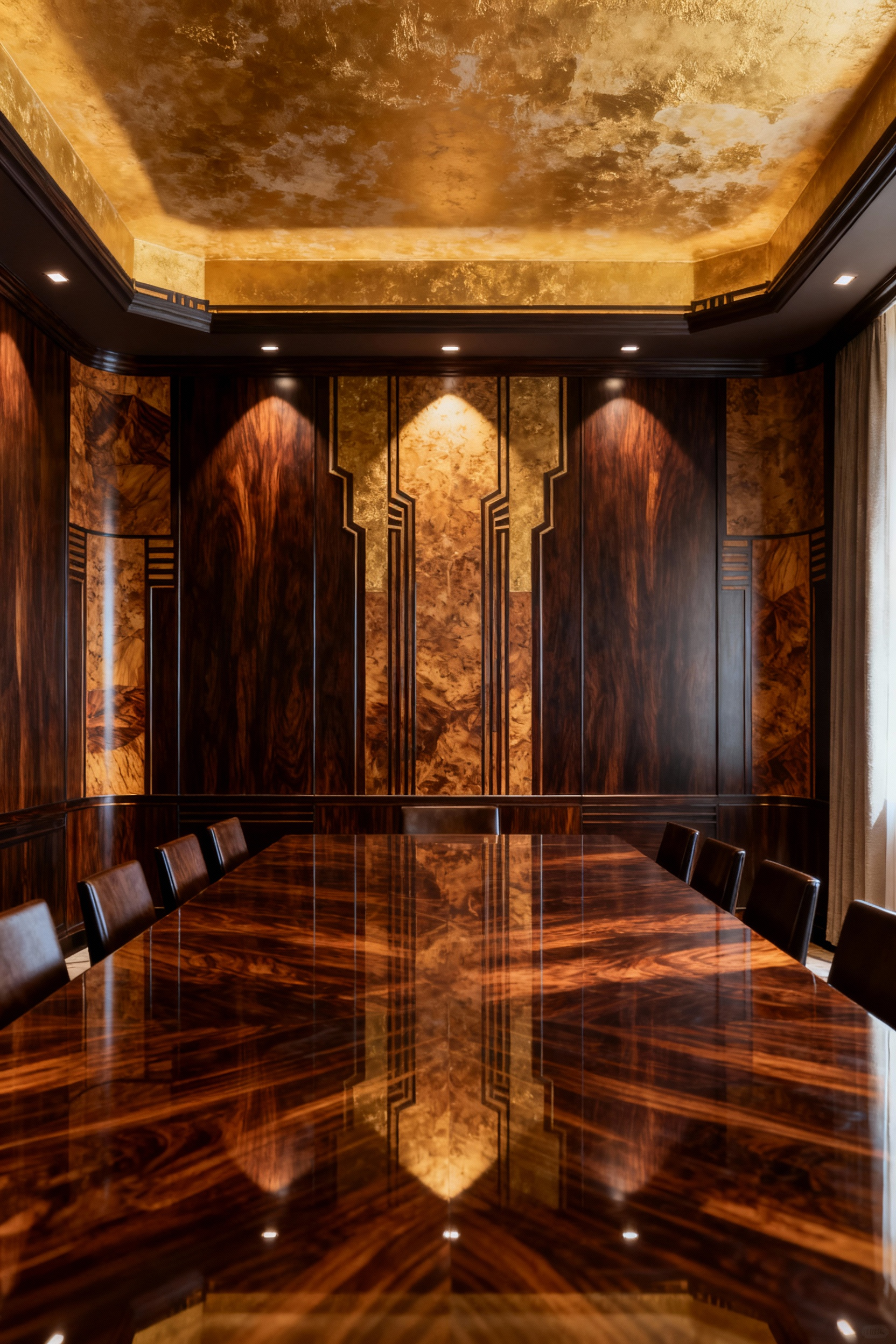
Paneling can also strategically conceal doors or storage, maintaining the room’s serene continuity. For a more contemporary feel, large-format, book-matched stone slabs can create breathtaking feature walls. Artisan plaster finishes, from Venetian stucco to bespoke bas-reliefs, offer unparalleled texture. Each treatment must be chosen not only for its beauty but for its resonance with the overarching style, ensuring every glance offers a new discovery of refined detail.
13. Choreographing Transitional Vignettes: Defining Ancillary Furnishings for Experiential Continuity
The dining table and chairs are merely the nucleus of the experience. True artistry lies in the choreography of ancillary furnishings that define transitional vignettes and ensure experiential continuity. These secondary pieces—sideboards, consoles, bar carts—are integral components of a holistic design, linking the various elements of the room with grace and purpose.
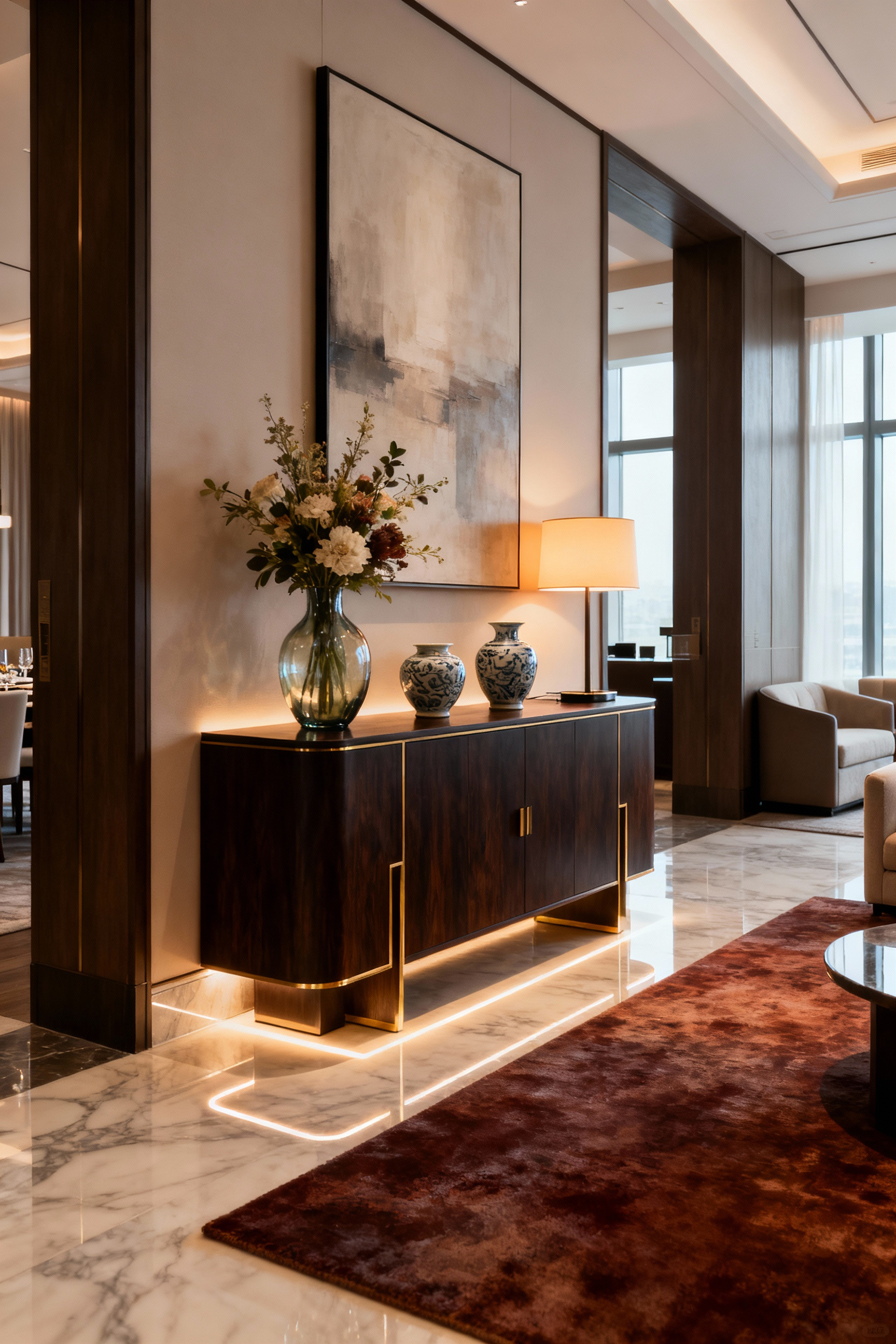
A well-placed, custom drinks cabinet, meticulously appointed with crystal decanters, serves as an invitation for an extended evening of conviviality. Thoughtfully positioned occasional seating, like a pair of host chairs by a fireplace, can establish a pre- or post-dinner conversational nook. This meticulous curation of secondary elements is what elevates a dining room from a functional space to a dynamic, richly layered environment. In my experience with Color Theory, these ancillary pieces are the perfect place to introduce a surprising accent color or a unique material that adds a layer of unexpected delight to the overall design story.
The Convivial Nexus: Philosophical Underpinnings and Archetypal Paradigms of Elevated Dining Spaces (Part 1)
An exceptional dining experience is an orchestrated sensory and social encounter, rooted in a philosophy of space and human connection. This section explores the foundational archetypes and subtle influences that shape opulent dining room designs, from historical echoes to multisensory engagements that define convivial splendor.
14. Deconstructing Archetypal Dining Sanctuaries: Lessons from Historical Precedents in Grandiosity
The modern concept of a grand dining room is deeply indebted to history, where breaking bread was often a ceremonial, power-infused event. The banqueting halls of medieval castles were designed to awe, while Renaissance palatial salons were meticulously stage-managed backdrops for social theater. Every detail, from a painting’s placement to the flow of traffic, was part of a carefully curated experience.
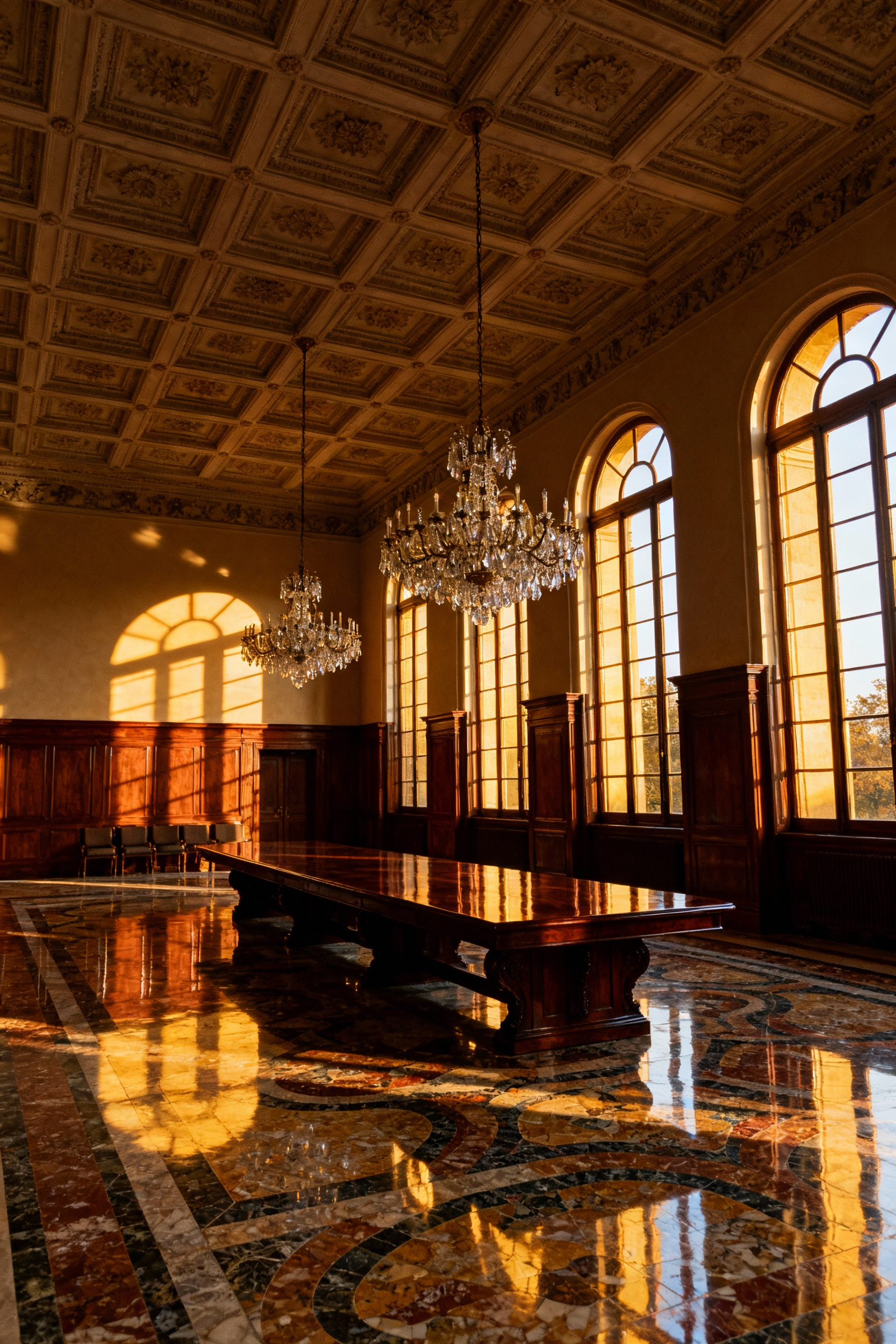
The lesson here is that grandiosity isn’t about size alone; it’s about the choreography of elements to create an atmosphere of profound importance. Contemporary dining room designs subtly reinterpret these principles—echoing spatial hierarchy, employing bespoke materials to convey timelessness, and designing for an inherent, if quieter, theatricality. The sense of occasion remains a direct descendant of these formidable historical lineages.
15. Engendering the Sensory Symphony: Crafting Multisensory Engagement Beyond the Visual
A truly transcendental experience engages all the senses in a harmonious symphony. The visual appeal sets the stage, but astute designers choreograph a full multisensory encounter. The auditory realm is crucial: optimal acoustics foster intimate conversation. The olfactory dimension is equally powerful; fresh florals or the delicate scent of natural woods can subtly elevate the atmosphere without overpowering the cuisine.
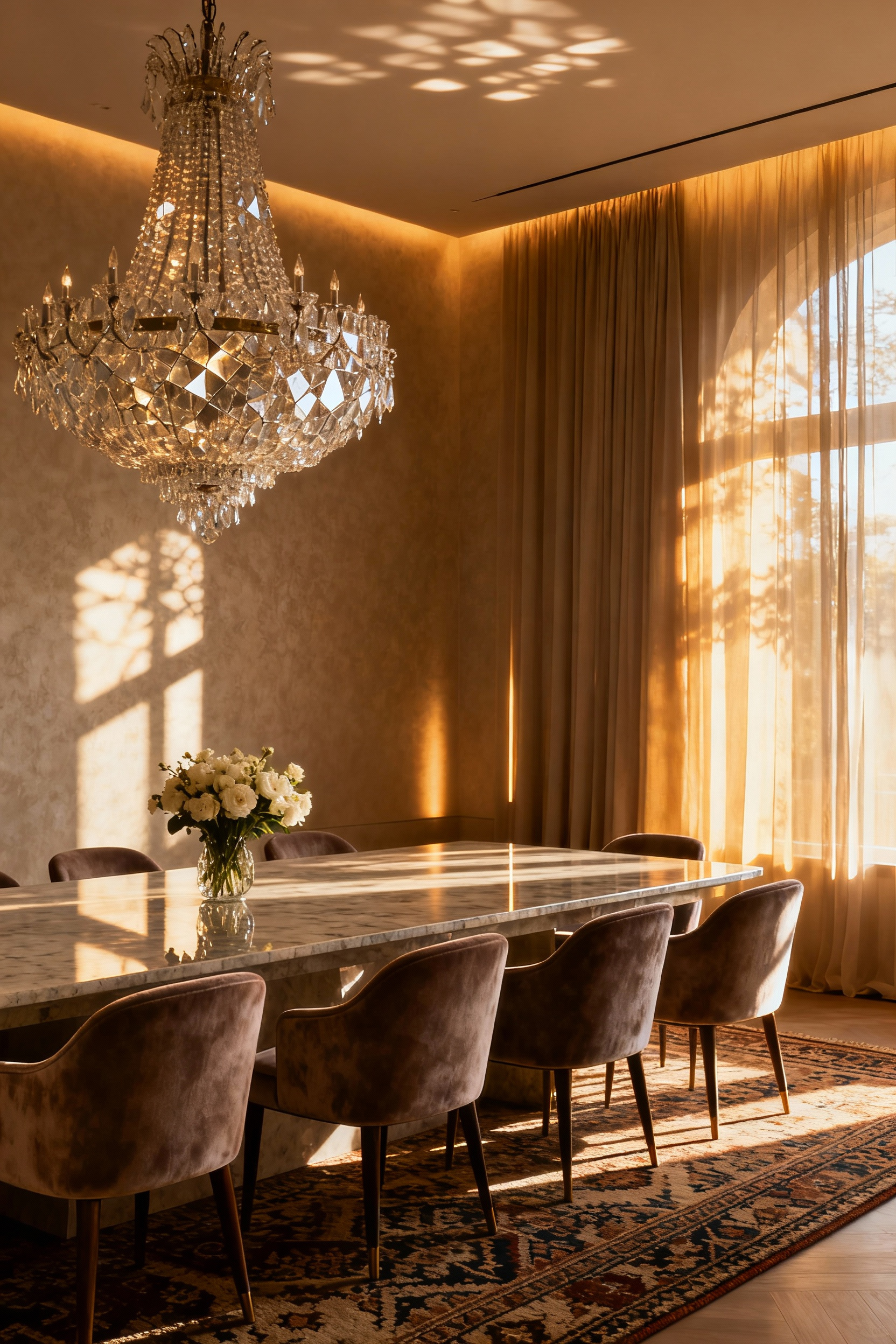
Then there is the tactile experience, often overlooked but integral to pleasure—the cool weight of fine silverware, the soft embrace of sumptuous fabrics, the smooth finish of the table. I often advise clients to close their eyes and imagine the room. What do you hear? How will it smell? What do you feel? This multisensory approach is what transforms a meal into a complete sensory apotheosis.
16. Echoing the Patrons’ Persona: Infusing Individual Narratives through Curated Memorabilia and Heirloom Integration
A private dining room should be a vibrant expression of its owners’ persona, history, and passions. This is achieved by meticulously curating memorabilia, art, and heirlooms that tell the inhabitants’ story. It is an exercise in storytelling where each object contributes a chapter to the family’s saga.
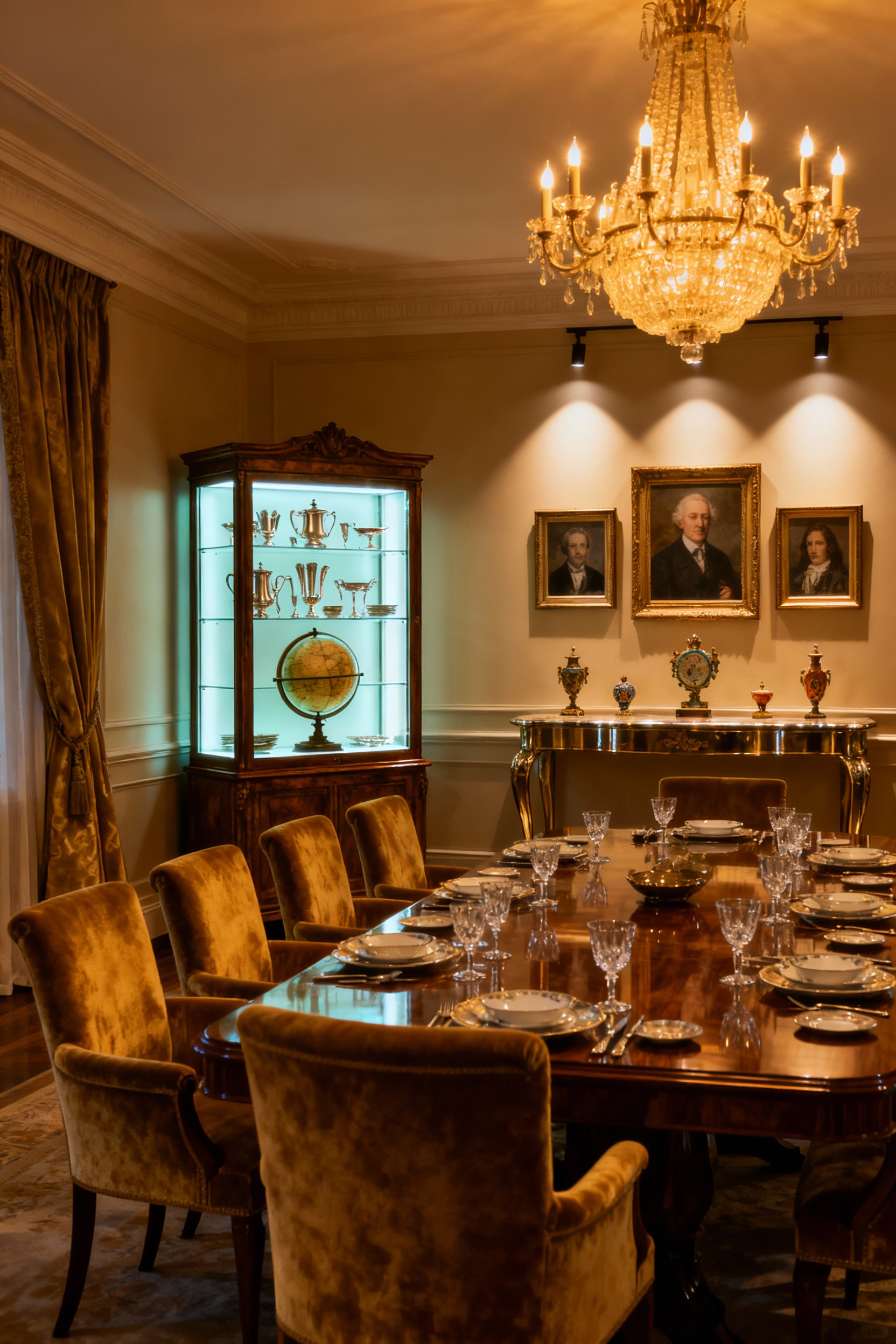
Rather than just decorating, this involves the thoughtful placement of meaningful pieces—a collection of antique silver from global travels, a powerful ancestral portrait, or a custom light fixture incorporating a family motif. The skill lies in integrating these personal effects seamlessly so they enhance the room’s sophistication. This transforms a space of aesthetic grandeur into a living testament to its occupants’ unique journey.
17. Architecting the ‘Reveal’: Guiding the Perceptual Journey into the Dining Experience
The psychological impact of a dining space begins long before anyone sits down. It commences with the ‘reveal’—the deliberate architectural orchestration that guides the perceptual journey. Elite dining room designs use transitional spaces to build anticipation and define the sense of occasion, using foyers or grand hallways as prefaces to the main event.
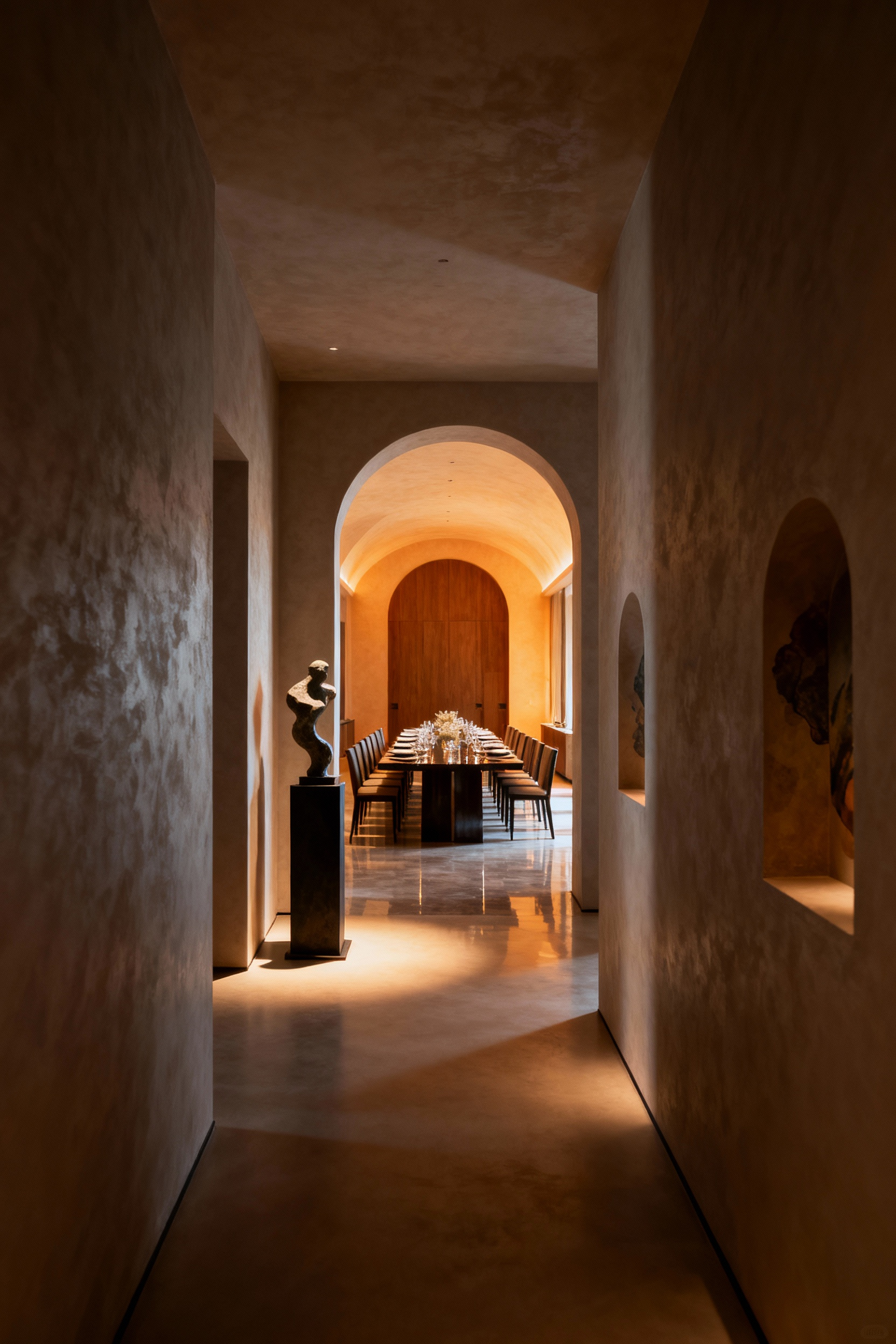
A designer’s mastery is in how these spaces create a sequential unfolding. This could be a dimly lit corridor opening into a dramatically illuminated room, creating a moment of delightful surprise. Thresholds can be accentuated by changes in flooring, ceiling height, or even scent. This mindful architecture of entry transforms the simple act of walking into a room into a carefully curated prelude to convivial splendor.
The Convivial Nexus: Philosophical Underpinnings and Archetypal Paradigms of Elevated Dining Spaces (Part 2)
Continuing our journey into the art of the convivial sphere, this segment delves into the ethical and forward-looking dimensions of transcendent dining room designs. Here, we examine the principles of sustainable stewardship, oenological curation, and the nascent traditions poised to shape the future of elevated communal experiences.
18. Embracing Perennial Stewardship: Integrating Sustainable Luxuries with Ethical Sourcing
The contemporary definition of luxury has evolved to embrace perennial stewardship. In the world of elite dining room designs, this means a commitment to integrating sustainable luxuries with rigorous ethical sourcing. True grandeur lies not just in aesthetic brilliance but in the provenance and impact of each chosen element.
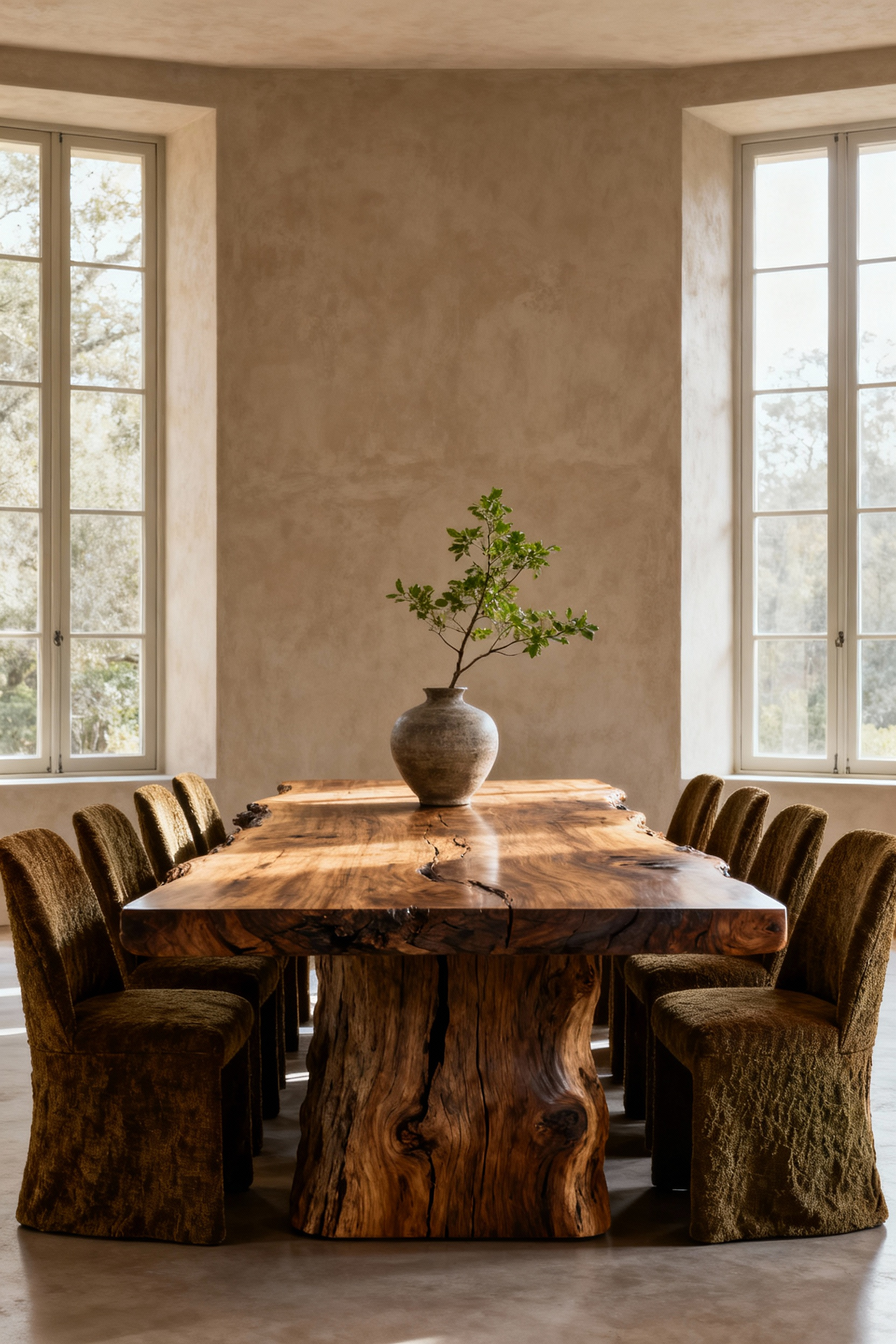
This is about investing in items that embody longevity and timelessness. Consider a table crafted from reclaimed ancient wood, bearing the patina of centuries. Upholstery in peace silk or organic linen introduces a layer of conscientious comfort. From my work in high-end interior design, I’ve seen a decisive shift. Clients are no longer just asking ‘Is it beautiful?’ but ‘Where did it come from?’ A piece with a story of ethical craftsmanship holds a value that transcends its price tag. This confluence of ecological imperative and aesthetic ambition redefines luxury for an enlightened age.
19. Foreseeing the Oenological Aesthetic: Curating a Bespoke Wine Receptacle as a Statement Piece
The art of connoisseurship now extends to the sanctuary where fine wines repose. In modern dining rooms, the humble wine rack has become a statement piece—an oenological aesthetic that speaks volumes. No longer relegated to a cellar, the bespoke wine receptacle now serves as a sculptural exhibit, transforming storage into celebration.
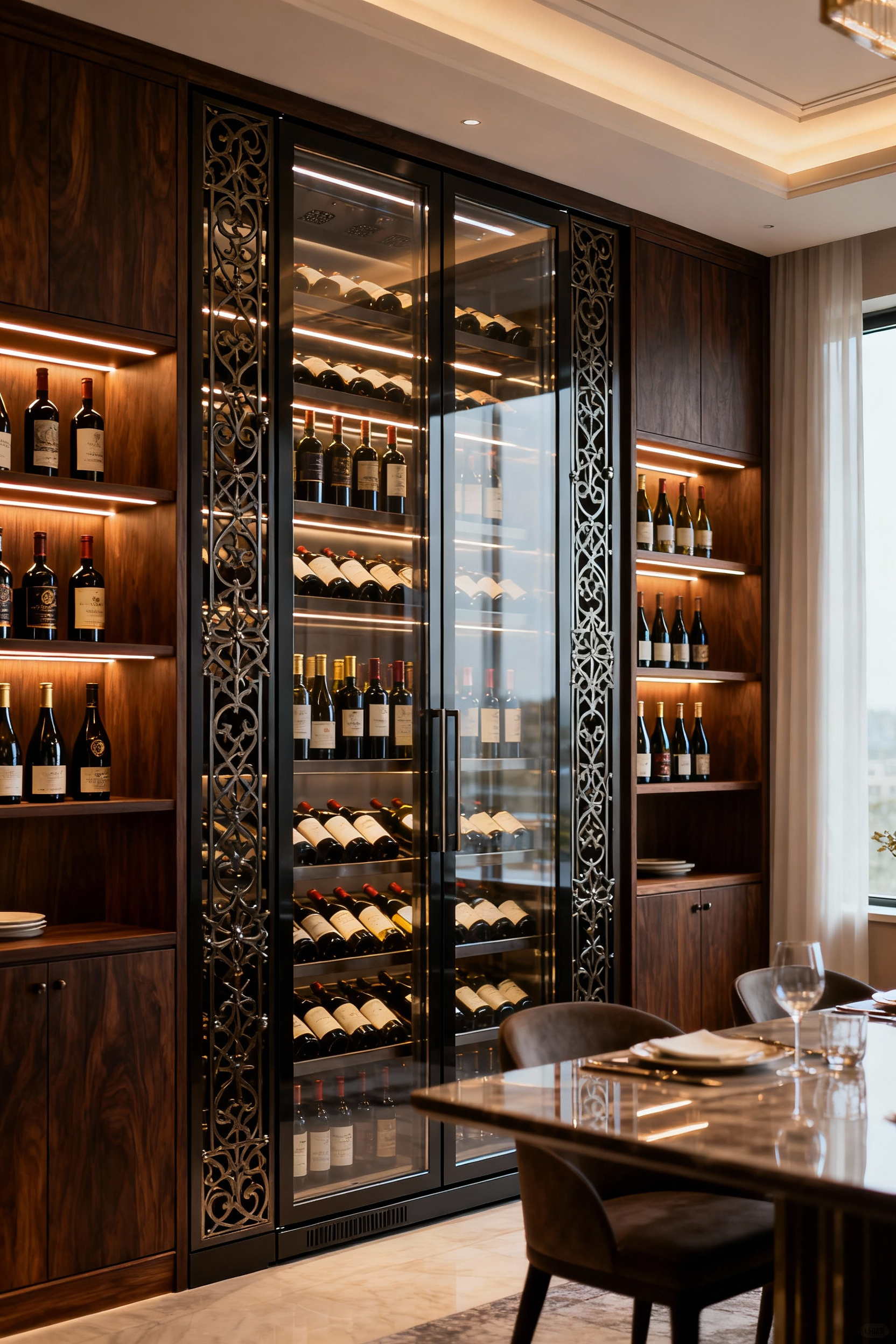
Imagine a temperature-controlled glass enclosure serving as a floor-to-ceiling accent wall, framing a collection with backlit reverence. Each bottle becomes an artistic element. Materials are chosen with exacting precision: rich woods like wenge provide timeless gravitas, while polished steel introduces a contemporary edge. This curated display serves not only as a testament to exceptional taste but as an invitation for convivial engagement.
20. Legacy of the Liminal Threshold: Anticipating Future Traditions in Elevated Conviviality
The dining room stands at a liminal threshold, poised between heritage and an avant-garde future. The next iteration of luxury dining will be defined by its adaptive intelligence and seamless integration of sensory enhancement that deepens—rather than diminishes—human connection.
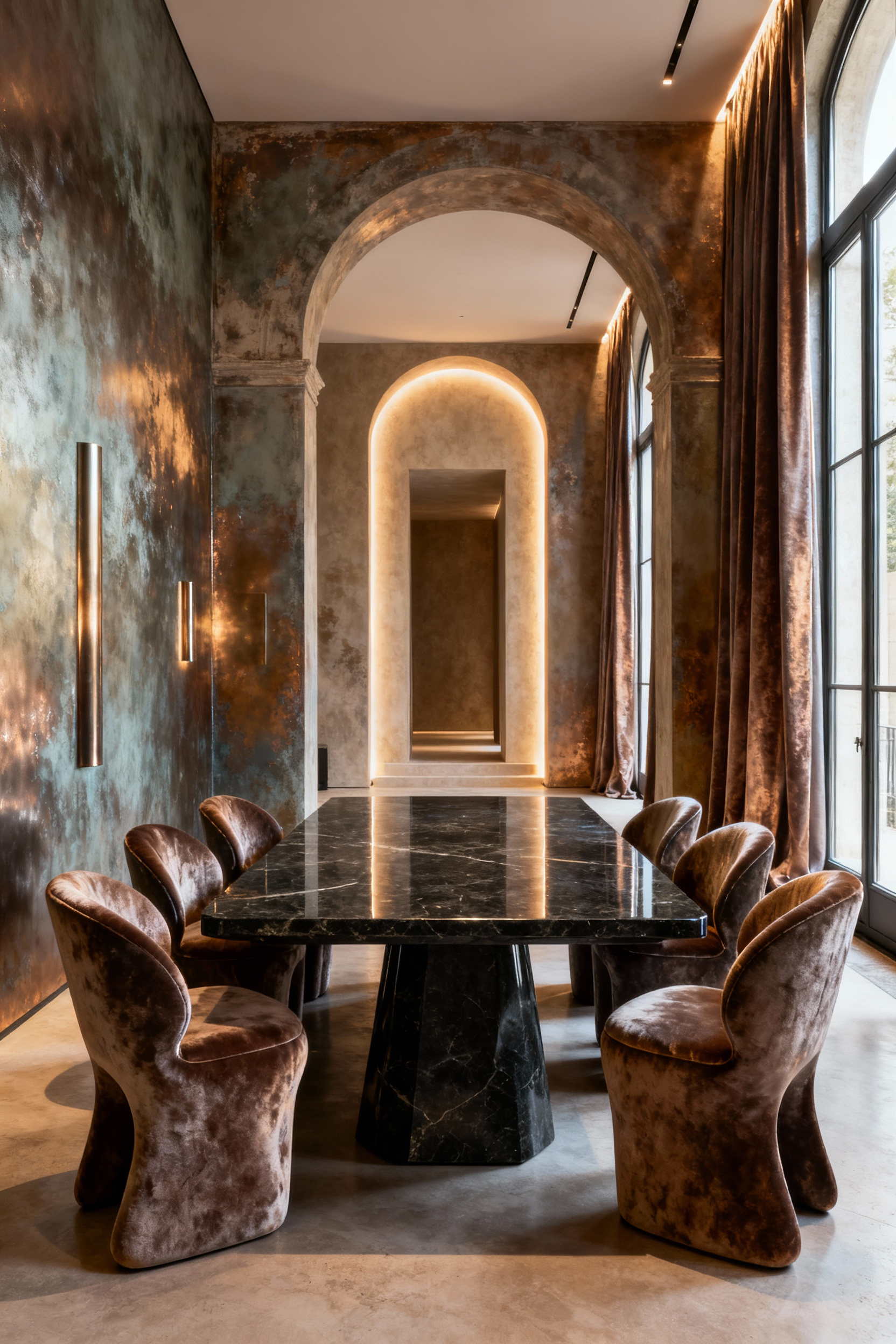
Envision spaces where the physical and digital converge. Smart surfaces could project interactive menus or immersive artistic backdrops. Ambient lighting could adjust its chromatic temperature to complement the meal. What I find most exciting is the potential for hyper-personalization—not through ostentation, but through intuitive design that anticipates every desire. This is about creating environments where new rituals can emerge, forging a new paradigm of convivial splendor.
Conclusion
Having traversed these twenty paradigms for luxury dining room designs, we arrive at a deeper appreciation for the art of intentional living. These principles reveal that genuine luxury is born from a mindful convergence of form, function, and an emotional resonance that transforms everyday meals into cherished rituals. Crafting such an environment demands not only an astute aesthetic sense but a profound understanding of how spaces shape our lives.
Let these paradigms serve as more than inspiration; may they be a catalyst for your own pursuit of domestic grandeur, inviting you to create spaces that reflect your highest aspirations. The most memorable dining experiences are not simply witnessed but deeply felt—powerful reflections of a life thoughtfully designed and beautifully shared, where every meal becomes a celebration of both refined taste and enduring connection.
